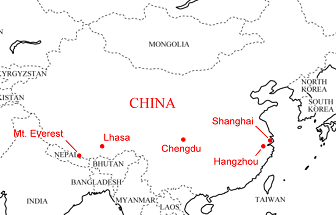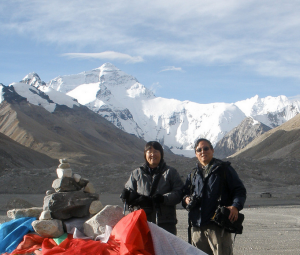
Although we had already visited China several times, on this trip we were able visit many new places. Unfortunately, three words sum up much of China and, indeed, Asia, in late July: hot and humid. Make that four words: unbearably hot and humid! To reduce the time spent in these conditions, we flew in just a few days before the eclipse.
One new concern this trip was the fear of H1N1/swine flu. We were screened on arrival in both Korea and China for flu symptoms. If we, or anyone we happened to be sitting near, appeared ill, we could all have been quarantined for a week! At one point we actually moved to new seats to be far from a sickly passenger, filling out new health questionnaires to record that we were not sitting anywhere near him. Fortunately we passed through without problems; in fact even the sick guy made it through ok.
We have been to Shanghai several times but had never toured the Yuyuan Gardens, near the center of the Old City. We really enjoyed it. Created in the Ming Dynasty, the garden is filled with ponds and remarkable rock formations and is cleverly designed to give the feeling of cliffs, gorges, and caves, all in a compact area. Other sections feature walls and rooftops decorated with dragons, which particularly fascinated me, since I had spent many hours studying Chinese dragons to come up with the pinhole design for the eclipse.
 Hangzhou, about three hours by bus from Shanghai, was the base of operations
for the eclipse tour. We took a boat ride on the famous West Lake, and
visited a tea plantation where we bought some of the unbelievably expensive
dragonwell tea, the officially designated "famous tea of China." The tea is
heat processed by hand and produces a gentle but rich flavor. It is quite
different from Japanese green tea, in that when you add hot water to the
leaves, they brew up to look just like, well, leaves. Big leaves, floating
around in your cup. But even after 5 or 6 refillings, they still produce a
nicely flavored tea, which is pretty amazing.
Hangzhou, about three hours by bus from Shanghai, was the base of operations
for the eclipse tour. We took a boat ride on the famous West Lake, and
visited a tea plantation where we bought some of the unbelievably expensive
dragonwell tea, the officially designated "famous tea of China." The tea is
heat processed by hand and produces a gentle but rich flavor. It is quite
different from Japanese green tea, in that when you add hot water to the
leaves, they brew up to look just like, well, leaves. Big leaves, floating
around in your cup. But even after 5 or 6 refillings, they still produce a
nicely flavored tea, which is pretty amazing.
After Hangzhou, we visited Chengdu, the capital of Sichuan province, where we had the best Chinese food we had ever tasted (and, luckily for Dave, it wasn’t spicy!). We also had a nice walk in Wangjiang Lou Park, where we saw dozens of groups performing various styles of tai chi, from unarmed to sword forms to forms with fans, as well as other types of exercise, including ballroom dancing!
We also visited the Bifengxia Panda Research Base a couple of hours drive from Chengdu, where we were able to see many juvenile, but nonetheless huge, pandas at play.
From Chengdu we flew to Lhasa, the capital of Tibet. We were supposed to tour Tibet when we went to China for last year’s eclipse trip, but the Chinese government closed it off to visitors due to the world-wide protests in support of the Tibetan people. Last minute unrest in the western part of China made us fear another closure this year, which luckily did not occur. However, we did see many Chinese troops in Lhasa, including a huge line of armored personnel carriers. We had adequate paperwork so we had no problems, although we were warned not to take pictures of the troops, nor show pictures of the Dalai Lama or the Tibetan flag. If Tibetans did this, they would face life imprisonment.
In Lhasa we saw many important sights, including the famous Jokhang Temple, Sera and Drepung Monasteries, as well as the Potala Palace and Norbulingka, the winter and summer homes of the Dalai Lama. Sadly, the Dalai Lama lives in exile, the monks and nuns have been regulated down to a fraction of their former numbers, and many of the monasteries are still in ruins.
But what we were able to see was very impressive. Barkhor, the famous area surrounding Jokhang Temple, was filled with pilgrims circumambulating the temple, shopping at the stalls, and praying and prostrating in the public square. The streets of the Barkhor were filled with merchants selling everything from yak butter to DVDs of Buddhist sermons!
When we were young and into winter mountaineering, it was our dream to visit Everest Base Camp. Back then, it required a long, grueling trek from the Katmandu side of the Himalayas. Today, you can drive from Lhasa to EBC. But it is highly advisable that you take your time doing this, as Lhasa itself is at 12,000 feet, and the road to EBC includes several passes over 17,000 feet high.
After spending three days in Lhasa to give ourselves some time to acclimate to the altitude, we drove to Shigatse, which is a little higher than Lhasa. It is also the second largest city in Tibet (population 80,000) and home to Tashilhunpo, another very important monastery.
 Cloudy weather had us fearing we would never be able to see Mount Everest,
but on our sixth day in Tibet we finally reached Rongphu Monastery, the
highest monastery in the world, where the clouds parted enough to give us
a good glimpse of the mountain. The skies cleared up completely that night,
and we were able to get some amazing shots from our guest house window.
Cloudy weather had us fearing we would never be able to see Mount Everest,
but on our sixth day in Tibet we finally reached Rongphu Monastery, the
highest monastery in the world, where the clouds parted enough to give us
a good glimpse of the mountain. The skies cleared up completely that night,
and we were able to get some amazing shots from our guest house window.
The highpoint of the trip was going to EBC the next morning. The skies were perfectly clear, and we had amazing views of Mt Everest. We even huffed and puffed our way up a small hill a short way from camp. Not quite the same as trekking from Nepal, but very rewarding nonetheless!
See more images at our trip photo album.